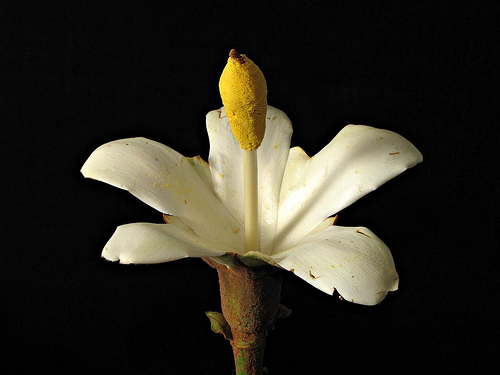Buffo the truffle-hunting dog, night-blooming balsa trees and fire-ant-made rafts
 Truffle shuffle: According to a letter published in the April issue of Frontiers in Ecology and the Environment, Buffo the truffle-hunting dog made an unusual find: a one-pound Burgundy truffle in the forests of southern Germany in November. As lead author Ulf Büntgen said in a recent Wired Science article, “This wasn’t a small find, but a big and expensive truffle with lots of smaller ones around. It was strange to find it in an area where, so far, this truffle’s existence has never been reported…The season, early November, was also unusual. This led us to ask, ‘what is driving truffle growth here? Is it connected to climate?’” Read more at “Truffle-Hunting Dog Finds Jackpot in Unexpected Place.”
Truffle shuffle: According to a letter published in the April issue of Frontiers in Ecology and the Environment, Buffo the truffle-hunting dog made an unusual find: a one-pound Burgundy truffle in the forests of southern Germany in November. As lead author Ulf Büntgen said in a recent Wired Science article, “This wasn’t a small find, but a big and expensive truffle with lots of smaller ones around. It was strange to find it in an area where, so far, this truffle’s existence has never been reported…The season, early November, was also unusual. This led us to ask, ‘what is driving truffle growth here? Is it connected to climate?’” Read more at “Truffle-Hunting Dog Finds Jackpot in Unexpected Place.”
Blooming balsa: Large, blooming balsa trees attract wildlife in the night with their nectar-laden blossoms. Natalie Angier elaborated in a National Geographic article: “When [the capuchin monkeys] look up again, their muzzles are speckled with pollen, which from the [balsa] tree’s perspective is the whole point of its flowers: to capture the attention of a pollinator long enough that the animal can’t help but be brushed with the plant’s equivalent of semen, which, if all goes well, the inadvertent matchmaker will eventually deliver to the female parts of another balsa tree’s flowers. The exchange is simple: You get drinks on the house, my gametes get a ride on your face.” Read more at “Panama’s Ochroma Trees.”
Deepwater update: One year after the Deepwater Horizon explosion sent oil leaking into the Gulf of Mexico, scientists are still researching the longterm ecological impact of an incident that is unique in many ways. That is, “[t]he field of coral was just 11 kilometres from the Deepwater Horizon well head, which earlier in the year had spewed out more than 4 million barrels of oil and a similar amount of methane—the largest ever accidental release in the ocean,” wrote Mark Schrope in a Nature article. “The spill was unique in other ways, too. Located beyond the continental shelf and some 1,400 metres below the surface, it happened in deeper water than any other major spill in history.” Read more at “Oil spill: Deep wounds.”
Peacock spots: Mate selection in peacocks may be more complex than previously thought. That is, the number of eyespots on a male peacock’s feathers is likely not the only factor responsible for female’s mate selection.“The threshold idea certainly makes sense at first glance, says Adeline Loyau, a peacock researcher at the CNRS research station in Moulis, France,” in a Science News article by Susan Milius. “The struggle to understand the long-familiar peacock, adds [Loyau], ‘suggests that we are still far from unraveling the mechanisms of mate choice.’” Read more at “The eyespots have it after all.”
Fire ant raft: The fire ant (Solenopsis invicta) copes with heavy rain in Argentina by linking together and forming a living raft of ants (see below video). Ed Yong from Not Exactly Rocket Science explains the research by Nathan Mlot from the Georgia Institute of Technology which explores this survival technique: “By trapping bubbles around and between their bodies, the ants also ensure that they can breathe and float. The bubbles slash the density of their self-made raft by a whopping 75%. An individual ant may be denser than water, but a raft of ants is far less dense. That’s why it floats. Even if Mlot pushed the raft down with a stick, it still refused to sink. The ants ‘dented’ the water, but they wouldn’t go under it.” Read more at “Fire ants assemble into living waterproof rafts.”
Also, queen bee protein, Chernobyl’s wildlife, the price of an endangered bird, drought and fires in Texas, orchids fake infection, interview on an essay discussing the climate debate, Betula nana in Arctic tundra and Colombia’s ecosystems threatened by gold and coal rushes.
Photo Credit: Mauricio Mercadante